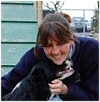| |
Spot the common theme...
10 top training tips that could change your agility life. We
asked ten of the best known trainers in the UK to share their secrets. Next time you go to
training or into the ring, just try one of these suggestions. It could make all the difference.
The
Contributors
 |
 |
 |
 |
 |
 |
 |
 |
 |
 |
|
Lu Candy |
Steve Croxford |
Leah Gardner |
Lee Gibson |
Mary Ann Nester |
David Munnings |
Lesley Olden |
Bob Sharpe |
Kathrin Tasker |
Dawn Weaver |
| |
|
|
|
|
|
|
|
|
|
 |
Never blame your dog. If it goes it wrong, it is
either the fault of your handling or a fault in your training of the dog. They only want
to get it right. If the information we have trained into them or imparted to them on the
day is wrong, it is our fault NOT theirs.
Lu Candy
More:
www.scramblesdts.com |
 |
Always have a plan
before you start any training session. Have a clear idea about what you want to do and
what you want to achieve. Never blame the dog for your inconsistency or poor results.
What you see in the competition ring is normally the direct result of your training
approach and methods. Steve Croxford
More:
www.PACE-Agility.com
|
 |
Invest time into play. It can be play with a toy or
just with you. It's a great bond enforcer as well as a brilliant form of praise. And
remember to drop your shoulders and look disappointed can be as bad as screaming at your
dog so finish every round with a smile. Leah Gardner
More:
www.anjuagility.co.uk
|
 |
One golden rule I use in my training is that no matter
where you are in the course, your body language should be reinforcing what you are
saying/instructing the dog to do. If it is not, you cannot blame the dog for perhaps
choosing the wrong obstacle or making an error.
I always teach my dogs to read from verbal commands,
and body language acts as reinforcement, not guidance. I know my dogs are far quicker
than I am, and I want them to be 100% confident that they have my trust and belief when
they are working the course, and making vital decisions based on my instructions. If they
have that confidence, I know they will attack every element of that course without any
doubt. Lee Gibson
More:
www.leegibsontraining.co.uk
|
 |
Make it fun
and never blame the dog for your handling and training mistakes.
David Munnings
More:
www.freewebs.com/davemunnings |
 |
If you are
sick of finding biscuit crumbs and lumps of frankfurter in the lining of your pockets,
buy a treat bag and fix it to your belt or waist band. Keeps your clothes clean and stops
you smelling like the dog's dinner!
Mary Ann Nester
More:
www.aslanagility.com |
 |
Be Fair - before
criticising your dog remember who taught it!
Lesley Olden
More:
LESLEYOLDEN@aol.com
|
 |
The next time you get annoyed that your dog has not
followed your instruction and you are ready to accuse it of being naughty, remember who
trained it ? The fault almost certainly lies with you. Bob Sharpe
More:
www.fieldofdreamsdogtraining.co.uk |
 |
Train hard, train
every day, learn all possible agility positions and movements, then train some more! Sort
out all your arms and legs, get them doing the right signal at the right time in the
right place, do this again and again... on your own with an imaginary dog. Then ask your
dog if you are good enough to join him and have fun together!
Kathrin Tasker
More:
www.madkathagility.com
|
 |
Learn from your dog in training. When he goes in the
'wrong' direction, realize that you have cued him incorrectly. You should not withhold
from rewarding the dog when it is the handlers error. How many times does a sequence go
wrong and you go back, change your handling and try again without rewarding your dog?
Dawn Weaver
More:
www.dawnweaveragility.com
|
More tips...
Fail to prepare.
Prepare to fail.
Blair Cochrane
 Dogs
will only do what is rewarding to them so always make sure that whatever you are training is
worth their while. Remember to the dogs work should equal reward. Therefore work will become
rewarding to them. Don't be stingy! This way you will ensure a good working relationship
between the two of you. Lauren Langman Dogs
will only do what is rewarding to them so always make sure that whatever you are training is
worth their while. Remember to the dogs work should equal reward. Therefore work will become
rewarding to them. Don't be stingy! This way you will ensure a good working relationship
between the two of you. Lauren Langman
More:
www.devondogs.co.uk
 Failure
is the key to success. If I try something one thousand times and fail, but on the one
thousandth and one time I find a method that works, have I really failed? Failure
is the key to success. If I try something one thousand times and fail, but on the one
thousandth and one time I find a method that works, have I really failed?
Kenny Spottiswoode
More :
www.agilityzone.co.uk
 Consistency,
consistency consistency. Ensure to the best of your ability you are consistent in any
environment which will promote your dogs confidence in you, creating accurate and
motivated results. Natasha Wise Consistency,
consistency consistency. Ensure to the best of your ability you are consistent in any
environment which will promote your dogs confidence in you, creating accurate and
motivated results. Natasha Wise
| |
|